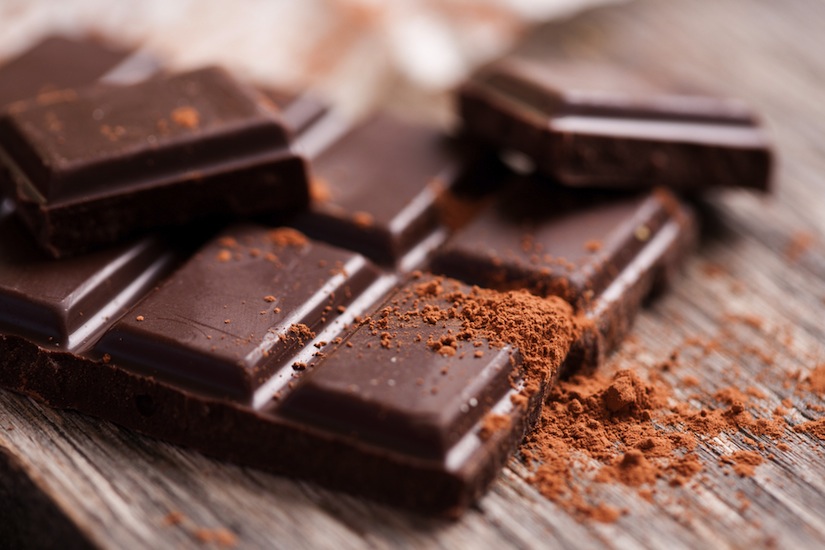
Chocoholics rejoice! The amount of evidence in favor of eating dark chocolate is increasing, so there’s no need to miss out.
Most believe the health benefits of chocolate stem from its key ingredient – cocoa. Increasingly, studies are linking regular cocoa consumption to a slimmer waistline, improved heart health, increased insulin sensitivity, and enhanced brain function. Rich in flavanols – a potent group of antioxidants, and minerals including magnesium, iron, potassium, calcium, zinc, copper, and manganese. A daily dose of cocoa may just help keep the doctor away!
Unfortunately, not all chocolates are created equal, so we’ve made things easy for you by listing our top priorities when choosing a chocolate fix!
Here Are The 7 Tips For Choosing A Healthy Dark Chocolate
1. CERTIFIED ORGANIC
Select chocolate products that are certified organic so that you can be sure they aren’t genetically engineered (GE). Unfortunately, most chocolate today (even dark chocolate) is GE. Food scientists have inserted foreign genes (genes from other plants or animals) into the genetic codes of genetically engineered foods, changing various aspects of the food, from how they grow, how they taste, and how they look. Reports on the complete safety of consuming GE foods are mixed. We’d rather stick to what nature has given us naturally!
2. PURE-STATE
The closer your cocoa is to its natural raw state, the higher its nutritional value. Ideally, you should consume your chocolate or cocoa in its raw form (cacao). Generally, the darker the chocolate, the higher the cacao content. However, cacao is fairly bitter, so the higher the percentage of cacao, the more bitter the chocolate will be. If you can opt for a bar made with raw cacao, otherwise, a dark chocolate bar made with organic cocoa is your next best option.
3. MINIMAL INGREDIENTS
The quickest way to determine if it’s a good choice is to check the ingredient list. Keep things simple and choose chocolate with cocoa or cacao as one of the top three ingredients. The higher it is on the list, the more of it is in there! The main components of good quality chocolate should be cocoa or cacao, cocoa butter or coconut oil, and a natural sweetener. Skip the ones with soy products, hydrogenated fats, milk solids, thickeners, humectants, and other unnecessary ingredients – they’re generally laden with chemicals and artificial ingredients, not health benefits!
4. LOWER SUGAR
Cocoa and cacao are naturally bitter, so producers often pair them with a lot of sugar to make them more palatable. Skip the cane sugar, corn syrup, fructose, high fructose corn syrup, artificial sweeteners, and other refined sugars. When checking the ingredient list, look for naturally sweetened varieties, such as honey, coconut sugar, or pure maple syrup, instead. Typically, the darker the chocolate you choose, the lower the sugar ntcontent; therefore, aim for chocolatete with 70% or more cocoa.
5. FATS
Fats found in good quality chocolate help slow down the absorption of sugar, lessening the insulin spike. Ideally, the type of fat in your chocolate bar should be what the natural plant—cocoa butter—contains. Cocoa butter contains a mix of palmitic, stearic, and oleic fatty acids. Stearic acid is the primary fatty acid, and it’s the only saturated fat that favorably affects HDL without adversely affecting LDL. Unrefined coconut oil is also a good choice, as it contains medium-chain triglycerides (MCT) that can help reduce triglyceride levels. The major MCT in coconut oil is lauric acid, which the body breaks down to monolaurin, providing antiviral and antibacterial properties too!
6. FAIRTRADE
Where possible, choose a bar of fair-trade chocolate. Purchasing fair trade products helps to support better prices, decent working conditions, local sustainability, and fair terms of trade for farmers and workers in the developing world.
7. QUALITY VS QUANTITY
Regardless of its health benefits, you can still have too much of a good thing! There is currently no specific dose determined, but small amounts, 1-3 times a day, appear to be most beneficial. If you’re watching your waistline, be mindful not to overdo the serving size, as the energy from chocolate’s fat and sugar content can add up quickly!


